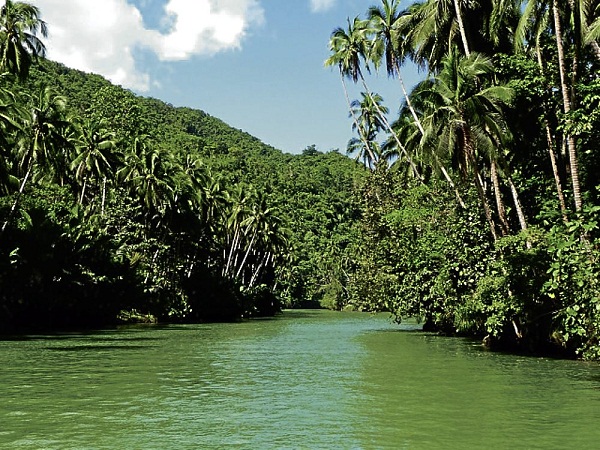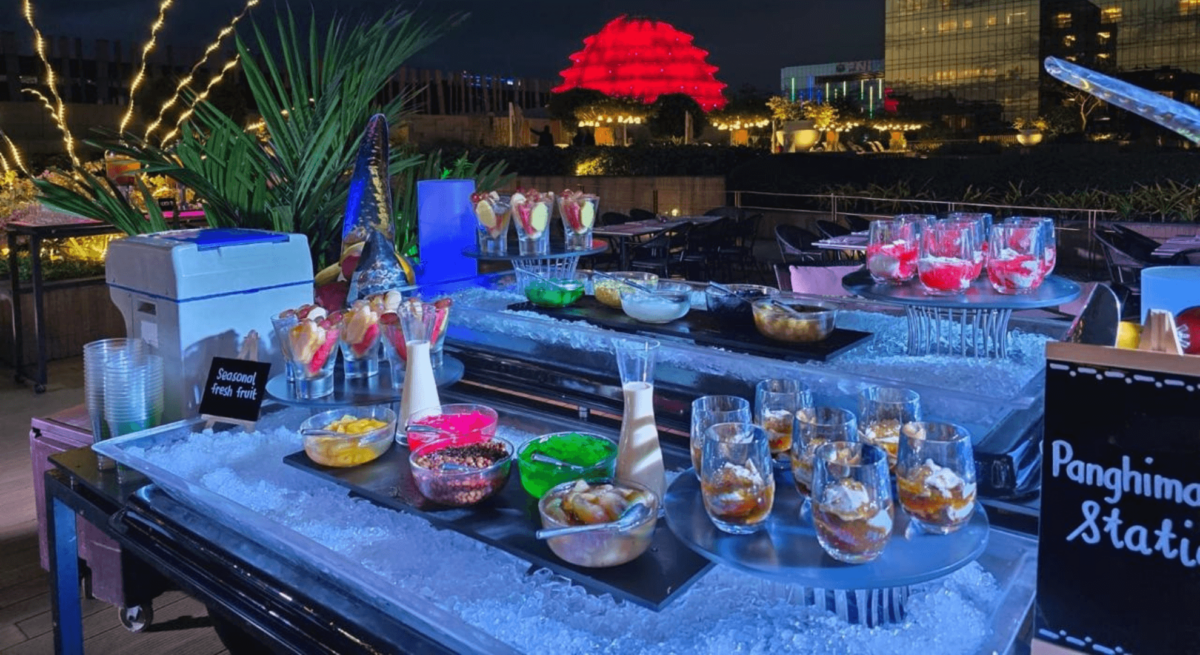
Mention Bohol, and most people think of the Chocolate Hills and the tarsiers. Those seeking the latest resorts may know of Panglao Island, just offshore from Tagbilaran. History buffs may know of old Spanish churches or of the Dagohoy Rebellion of 1744-1829, the longest and most successful revolt against Spain. Bohol is all this but much more, with the unexpectedness of its attractions adding to the pleasure they provide.
To be sure, the Chocolate Hills and the tarsiers are deserving of their reputation. The tarsiers are tiny creatures who sleep during the day, but this does not detract from their appeal. Visitors follow well-laid-out paths through the recently improved and expanded viewing area, and each tarsier, whose sapling is marked by a ribbon, draws an eager cluster of viewers.
The Chocolate Hills, brown in the dry season and green the rest of the year, are spectacular at any time. They spread across three towns. Formed by a limestone cap which retards erosion, their shape is unique. A central viewing area is accessed by a steep stairway or a less steep path. The view from the top is breathtaking.

Most visitors to Bohol are probably attracted by Panglao’s beach resorts. Panglao is a fairly extensive island, comprised of two towns, Dauis and Panglao, and is joined to Tagbilaran by two causeways. The tourist area is relatively recent and still expanding, but because of Panglao’s size, the tourist presence does not seem overwhelming. On our yearend holiday in Panglao, we stayed at the Alona Tropical Beach Resort and would highly recommend it. The facilities, beach, and service were all first-rate. For variety in meals, we walked down the beach to restaurants that offered fresh seafood, grilled to your taste, or strolled a block to the main road and the Paraiso, an excellent Chinese restaurant.
The hotel has a dive shop as well as diving instruction. For snorkeling, most vacationers choose a boat ride to Balicasag Island, home to about 1,000 residents including the banca men who ferry snorkelers from the larger boats to the edge of the coral reef. The charge for the bancas was P150 per person, while the hotel’s published rate for the larger boats was P2,800 for 6-10 passengers. Dolphin-watching may be included for an extra P200. On our return trip we stopped at Virgin Island, a narrow, fenced-off, protected island in the middle of two sand spits that disappear at high tide. Most found the sand spits irresistible and walked from one end into the water at the other end.
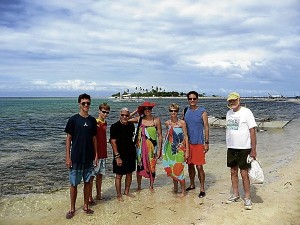
The Alona Tropical Beach Resort offers several tour packages, and our regular driver, Michael Mara, a graduate of the University of Bohol and a budding entrepreneur, proved an excellent tour guide. Without exhausting all that Bohol has to offer, we had one full day and parts of two others for sightseeing. We began with one of two competing sites for the Sandugo, the blood compact of 1565 between Miguel Legazpi and Datu Sikatuna. The site with what probably is the poorer historical claim has the better presentation—a life-size tableau of five men sealing their friendship with the blood compact. It’s ideal for picture-taking.
Baclayon Church, six kilometers east of Tagbilaran, is one of the best-preserved Jesuit churches in the region. Dating Philippine churches is an imprecise science, because early churches were made of perishable materials, often burned, and were commonly rebuilt to larger specifications and more enduring materials. Two Spanish Jesuit missionaries arrived in Bohol in November 1596 and established a mission at Baclayon. They soon erected a visita, a small barrio chapel.
Baclayon was the Jesuits’ first headquarters, or residencia, but fear of Moro raids soon caused them to transfer the residencia to the inland town of Loboc. It was not until 1717 that Baclayon became a parish and construction—coral blocks cemented together with egg whites and egg shells—was started on the present church. Work was completed in 1727. Though the stone church of Baclayon is far younger than the 1595 date often claimed for it, its 1727 completion makes it the oldest stone church in Bohol, followed closely by that in Loboc.
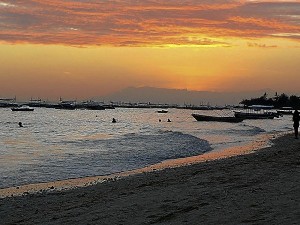
We made brief stops at Loay, where used tires are turned into attractive waste containers, and Albur, where knives and bolos are forged and ground. Then came Loboc.
Loboc, besides having a church originally built in 1602 and rebuilt in 1734, has three other claims to fame. Construction of a new road and bridge to replace the present one-lane bridge was halted when it was realized that continuing the bridge would demolish the church. The bridge, hanging in space, remains as a testimonial to poor planning.
Boholanos have an enduring musical tradition, and the Loboc Children’s Choir, drawing heavily on Spanish church music, rivals the Vienna Boys Choir. The choir has performed all over the world. We heard it at Dartmouth College in the United States, and it wowed the audience. During our stay in Bohol the choir performed at the resort next to ours.
This musical tradition was also evident in a river luncheon cruise upstream from Loboc. A rondalla band entertained us and other passengers as we waited to board our craft. Upstream, a chorus of children and adults on a platform beside the river serenaded each boat as it drew up. The luncheon cruise was relaxing and delightful.
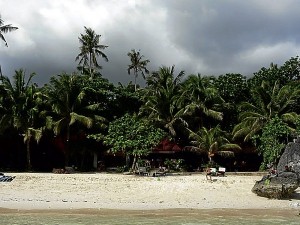
Philippine forests tend to be remote and degraded. The road from Loboc passes through the Bilar Man-made Forest. Consisting of 60 hectares planted 60 years ago, the forest is dark, cool, and inviting. Burned by the Japanese to root out guerrillas, the area was planted to mahogany during the Macapagal presidency. The larger trees are now impressive in girth and height.
The upstream cruise from Loboc features lunch. The downstream cruise from Loay features dinner and fireflies.
The male fireflies gather in particular trees, mangrove preferred, and flash their lights to attract the females hidden in the underbrush. The males communicate, and while at some trees they flash their lights at random, at others they synchronize their flashes, so that the whole tree seems to pulsate on and off. For those used to fireflies in the garden, this is a sight like no other.
No description of Bohol would be complete without mention of Prony the Python. Pythons don’t do much except, in Prony’s case, eat two goats every 30 days and grow bigger. So, although there are some other animals being exhibited along with the python, such as flying lemurs, there’s really not much to see. What makes the python exhibit worth noting is that Prony was captured in Bohol and, in the many years since his capture, has become enormous.
A brief detour on our return trip to the airport produced one of our holiday’s biggest surprises. We stopped at the Dauis church on Panglao to visit the souvenir shop. The Dauis church was founded by the Jesuits and became the residencia when the residencia was moved from Loboc in the second half of the 1700s. So it was once important, but today it seems sleepy and largely ignored.
Bohol has a tradition of metal works, including gilt-rimmed mirrors, and the church’s souvenir shop also offers colonial jewelry and carved wooden frames. A small museum has 3-dimensional murals and signs describing local history and customs. That was what we had come for.
Bohol has 47 towns, most of which have massive stone churches with frescoes and other reminders of Spanish times. Few would wish to see them all, and certainly the absence of visitors to the Dauis church while we were there gave little indication that the inside was special. However, the present church was not begun until late in the Spanish period and not completed until the 1920s, with further work done as late as 1970. Thus, what greets one as one enters the church is a massive structure with the entire ceiling painted with frescoes that remain as fresh and colorful as the day they were painted. If one chooses to see only one church in Bohol, this is the one.
Built according to a plan for basilicas, the church is one of the most complex and sophisticated structures of its kind in Bohol, and it compares favorably with churches in other parts of the world. It ought to be better known and more frequented. If you visit Bohol, by all means see the tarsiers and the Chocolate Hills, but also put the Dauis church on your list.

